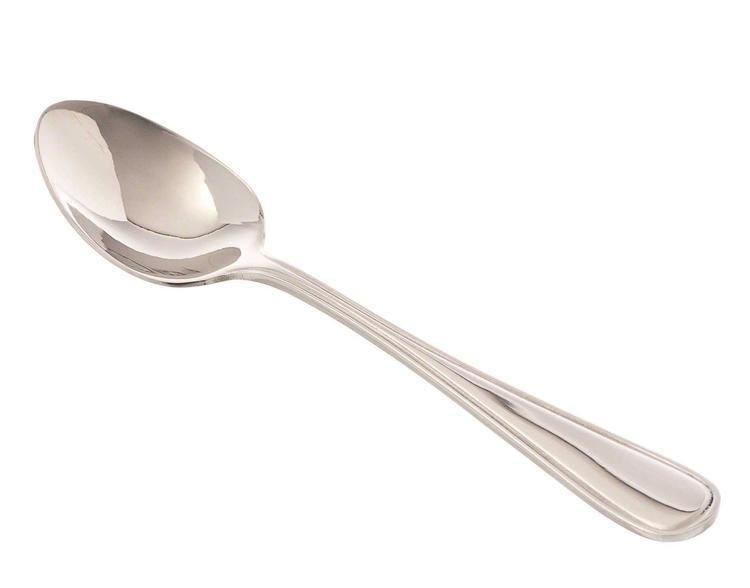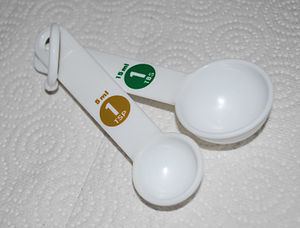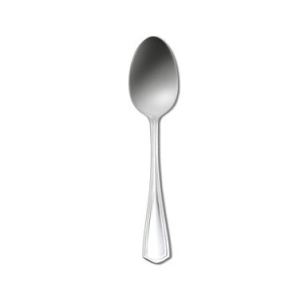A teaspoon is an item of cutlery, a measuring instrument, of approximately 5ml, or a unit of measurement of volume (usually abbreviated tsp.).
Contents
- Cutlery
- Measure of volume
- History
- United States customary teaspoon
- Metric teaspoon
- Alternative definitions
- References

Cutlery

A teaspoon is a small spoon suitable for stirring and sipping the contents of a cup of tea or coffee, or adding a portion of loose sugar to it. These spoons have bowls more or less oval in shape. Teaspoons are a common part of a place setting.

Teaspoons with longer handles, such as iced tea spoons, are commonly used also for ice cream desserts or floats. Similar spoons include the tablespoon and the dessert spoon, the latter intermediate in size between a teaspoon and a tablespoon, used in eating dessert and sometimes soup or cereals. Much less common is the coffee spoon, which is a smaller version of the teaspoon, intended for used with the small type of coffee cup. Another teaspoon, called an orange spoon (in American English: grapefruit spoon), tapers to a sharp point or teeth, and is used to separate citrus fruits from their membranes. A bar spoon, equivalent to a teaspoon, is used in measuring ingredients for mixed drinks.

A container designed to hold extra teaspoons, called a spooner, usually in a set with a covered sugar container, formed a part of Victorian table service.
The teaspoon is first mentioned in an advertisement in an 1686 edition of the London Gazette.
Measure of volume

In some countries, a teaspoon (occasionally "teaspoonful") is a unit of volume, especially widely used in cooking recipes and pharmaceutic prescriptions. In English it is abbreviated as tsp. or, less often, as t., ts., or tspn. The abbreviation is never capitalized because a capital letter is customarily reserved for the larger tablespoon ("Tbsp.", "T.", "Tbls.", or "Tb."). In German and Dutch teaspoon is abbreviated TL, for Teelöffel and Theelepel respectively.
History
See also Apothecaries' system.As an unofficial but once widely used unit of Apothecaries' measure, the teaspoon is equal to 1 fluid dram (or drachm) and thus 1⁄4 of a tablespoon or 1⁄8 of a fluid ounce. The Apothecaries' teaspoon (formerly tea spoon or tea-spoon) was formally known by the Latin cochleare minus, abbreviated cochl. min. to distinguish it from the tablespoon or cochleare majus (cochl. maj.).
When tea-drinking was first introduced to England circa 1660, tea was rare and expensive, as a consequence of which teacups and teaspoons were smaller than today. This situation persisted until about 1710, when the East India Company began importing tea directly from China. As the price of tea declined, the size of teacups and teaspoons increased. By the 1730s, the teaspoon as a unit of culinary measure had increased to 1⁄3 of a tablespoon, but the apothecary unit of measure remained the same. Nevertheless, the teaspoon, usually under its Latin name, continued to be used in Apothecaries' measures for several more decades, with the original definition of one fluid dram.
United States customary teaspoon
See United States customary units for relative volumes of these and other measures.In the United States one teaspoon as a unit of culinary measure is 1⁄3 tablespoon, that is, 4.92892159375 ml; it is exactly 1 1⁄3 US fluid drams, 1⁄6 US fl oz, 1⁄48 US cup, and 1⁄768 US liquid gallon and 77⁄256 or 0.30078125 cubic inches. For nutritional labeling on food packages in the US, the teaspoon is defined as precisely 5 ml. Common cutlery teaspoons are not designed to contain a standard volume. In practice, they may hold anything between 2.5 mL and 6 mL of liquid, so such spoons are not suitable for precise measurements, in particular for medicine. Measuring spoons should be used instead.
Metric teaspoon
The metric teaspoon as a unit of culinary measure is 5 mL, equivalent to 5 cm3; that is, 1⁄3 UK/Canadian metric tablespoon, or 1⁄4 Australian metric tablespoon.
Alternative definitions
If a recipe calls for a level teaspoon of a dry ingredient (salt, flour, etc.), this refers to an approximately leveled filling of the spoon, producing the same volume as for liquids. A rounded teaspoon is a larger but less precise measure, produced without leveling the ingredient off or heaping it as high as possible. A heaping or heaped teaspoon is a larger inexact measure consisting of the amount obtained by scooping the dry ingredient up without leveling it off. For some ingredients, e.g. flour, this quantity can vary considerably.
